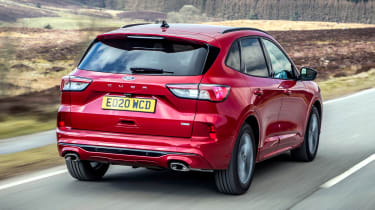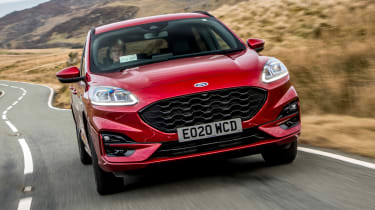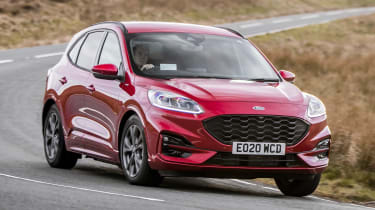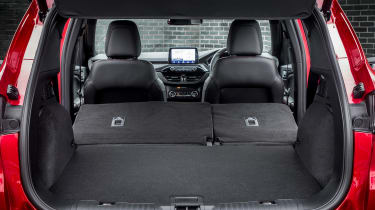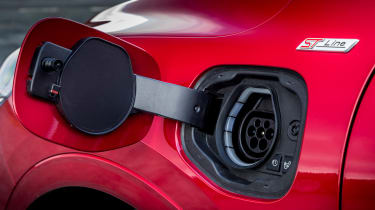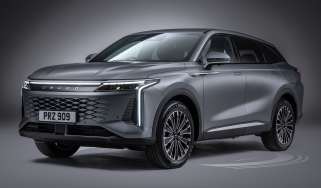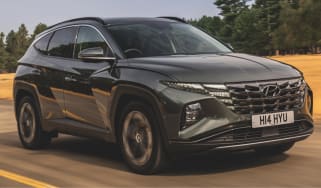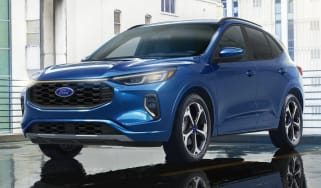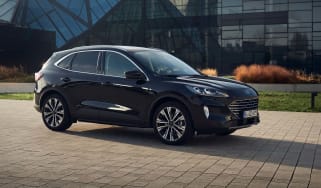Ford Kuga Plug-in Hybrid SUV review
"The Ford Kuga Plug-in Hybrid is good to drive and cheap to run, plus it’s ideal as a company car"
Pros
- Low CO2 emissions
- Electric range
- Fun to drive
Cons
- Underwhelming interior
- Sluggish gearbox
- Reduced boot space
Verdict - Is the Ford Kuga PHEV a good car?
It might not be the newest plug-in hybrid SUV on the block, but the Ford Kuga Plug-in Hybrid (PHEV) remains one of the best all-rounders in an increasingly congested market, combining low running costs with excellent practicality and driving characteristics that would shame some superminis and family hatchbacks.
Ford Kuga PHEV models, specs and alternatives
 Top 10 best plug-in hybrids on sale today
Top 10 best plug-in hybrids on sale today
Like the petrol and (now discontinued) diesel versions of the SUV, the Kuga PHEV is based on Ford’s C2 platform, which means it shares its underpinnings with the Focus hatchback. Even if ride and handling aren’t at the top of your list of priorities, you’ll enjoy the way The Kuga tackles roundabouts and country roads.
The Kuga combines a 2.5-litre petrol engine and a 14kWh battery pack to deliver the lowest running costs in the range. When the battery is fully charged – possible in 3.5 hours when using a household wallbox charger – the Kuga PHEV can travel up to 39 miles on electric power. In tests, we found that this is likely to be closer to 30 miles, which should be enough for a typical daily commute.
It’ll take six hours to charge the battery when using a standard three-pin household plug, which might come in handy if you’re visiting friends or relatives who don’t have access to a charging point.
More reviews
The engine and electric motor in the Kuga produce a total of 222bhp, so the PHEV is the most powerful car in the Kuga range. It’s good to drive, too, and is more fun than key rivals including the Toyota RAV4 Hybrid. However, the automatic gearbox in the Kuga is a bit sluggish and the car is quite heavy, so don’t expect strong performance – it’s quick enough, but nothing special.
The Kuga Plug-in Hybrid isn’t as practical as the other versions of the family SUV because the batteries take up extra space; the boot shrinks to 412 litres from 526, although there’s still lots of room for passengers and it’s more practical than the MINI Countryman PHEV. It’s also well-equipped, the SYNC3 infotainment system is easy to use, the ride is comfortable and it’s quiet inside. The cabin could be more interesting to look at, but the materials are good, so even though it’s relatively pricey, it’s still good value, particularly for company car buyers who will enjoy much lower tax than a diesel version.
MPG, running costs & CO2
It may come as a surprise that the Ford Kuga PHEV is fitted with a large 2.5-litre petrol engine, but as it's assisted by a potent electric motor, it doesn't have to work especially hard. Together, the petrol four-cylinder engine and electric motor can produce up to 222bhp, which is quite a bit more than standard versions of the Kuga.
When fully charged, the 14kWh battery pack can power the Kuga for a distance of up to 39 miles without using any petrol at all. In our experience, a range of 28-30 miles is more realistic in daily driving. You should also expect to see between 428 and 462 miles on petrol and electric power combined.
Fast charging isn't available but because the battery capacity is relatively small, charging from 0-100% only takes 3.5 hours using a 7.4kW home wallbox supply. If you have off-street parking, a full charge should be easy to achieve overnight. It's also possible to use the petrol engine to charge the batteries as you drive, but this causes fuel economy to plummet, so is only worth doing if you specifically want to build up charge before driving into a low emissions area. Charging with a three-pin plug takes six hours, so this will also be a viable option for anyone who hasn't had a wallbox installed.
The Kuga PHEV has an official fuel consumption figure of 256.8mpg, but as with all plug-in hybrids, this is entirely dependent on the length of your commute and how often you recharge the battery. The impressive CO2 figure of 23g/km is fixed, and represents a big advantage for company-car drivers thanks to the low Benefit-in-Kind liability it brings. VED (road tax) is slightly cheaper, but only by £10 per year compared with the standard rate. Insurance groups run from 19 for entry-level trims to 24 for the lavish Vignale, which is quite low compared with the Vauxhall Grandland (groups 24-32).
Engines, drive & performance
A headline figure of 222bhp almost suggests this Kuga is a performance SUV in disguise, but that's not how it feels from behind the wheel. The PHEV is quite heavy and tuned more for economy than rapid acceleration, so its 9.2-second 0-62mph acceleration figure is only average for the class. Its CVT automatic gearbox is one of the main obstacles to a sporty feel because the petrol engine drones quite loudly if you put your foot down.
Ford has a reputation for making some of the best handling family cars on sale, and while the outgoing Kuga lost some of this polish, the new car has recaptured the magic. It's now one of the best-handling cars in the class, with almost no lean through corners, even when switching directions. The steering is also accurate, even if it isn't as sharp as in other Ford models. For road use there's plenty of grip, but with front-wheel drive only, this isn't an SUV you'll want to take too far off the beaten track.
Interior & comfort
Some may find the lack of design flair inside the latest Kuga disappointing, while others will appreciate its simple, intuitive layout. Technology has taken a step up, thanks to an eight-inch tablet-style infotainment screen and digital instruments, with Ford's latest SYNC3 software making it easy to connect your smartphone. We also think the decision to leave chunky physical controls for the climate control is a good one because they're far less fiddly than trying to control it via a touchscreen on the move.
The PHEV is available across several trim levels but sadly not the cheapest Zetec or Titanium Edition specs. It kicks off in ST-Line Edition, so you'll get 18-inch alloy wheels, LED lights, dual-zone climate control, wireless smartphone charging and sat-nav. ST-Line adds sportier styling, digital instruments and a different set of wheels, while ST-Line X Edition brings luxuries like a powered tailgate, heated rear seats, a heated steering wheel, a panoramic sunroof and 19-inch alloys. If that's not enough, the range-topping Vignale spec is also available with premium leather and a head-up display, but it's all too easy to tip this version over £40,000, bringing a bigger VED (road tax) bill.
This can make a big difference, because while a Kuga PHEV with a list price below £40,000 costs £170 a year to tax from year two, a Vignale will cost an extra £390 a year for five years. That’s almost £2,000 more.
Practicality & boot space
Plug-in hybrids usually aren't quite as practical as conventional models because the battery sits beneath the boot, cutting into luggage space. Ford has limited this by fitting most of the hardware under the passenger compartment, so boot space only drops from 526 litres to 412 litres, which is still reasonable for family life. This expands to 1,481 litres with the seats folded, which isn't as much as the Toyota RAV4 but is more than the MINI Countryman PHEV.
Passenger space is generous, with plenty of space for adults as well as kids to stretch out in the back. There's no option of a third row of seats, but there are plenty of cubbies and door bins.
Reliability & safety
The Kuga was ranked an impressive 15th out of 75 cars in our Driver Power 2023 new car survey, ahead of many more expensive and supposedly premium models. The results were less favourable for Ford, which finished 28th out of 32 on the list of manufacturers. Only Renault, Audi, Fiat and MG were ranked lower.
The Kuga PHEV was part of a high-profile recall in 2020, with all plug-in hybrid models fitted with a new battery pack by Ford. This followed a small number of reports of fires caused by a manufacturing issue. Affected cars were provided with an extended warranty and a £500 fuel card as a goodwill gesture, while new cars have a revised battery design.
Independent safety body Euro NCAP has already tested the Kuga, giving it a five-star score thanks to its excellent crash-test performance. It scored 92% for adult safety, 86% for child safety and 82% for pedestrian protection. There's plenty of standard safety kit including lane-keeping assist, hill-start assist and autonomous emergency braking. The Driver Assistance pack adds blind-spot monitoring, traffic sign recognition and all-around cameras.


